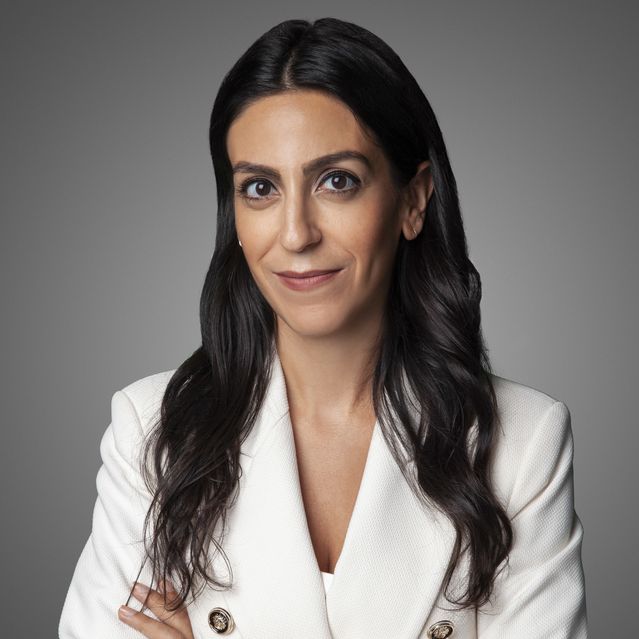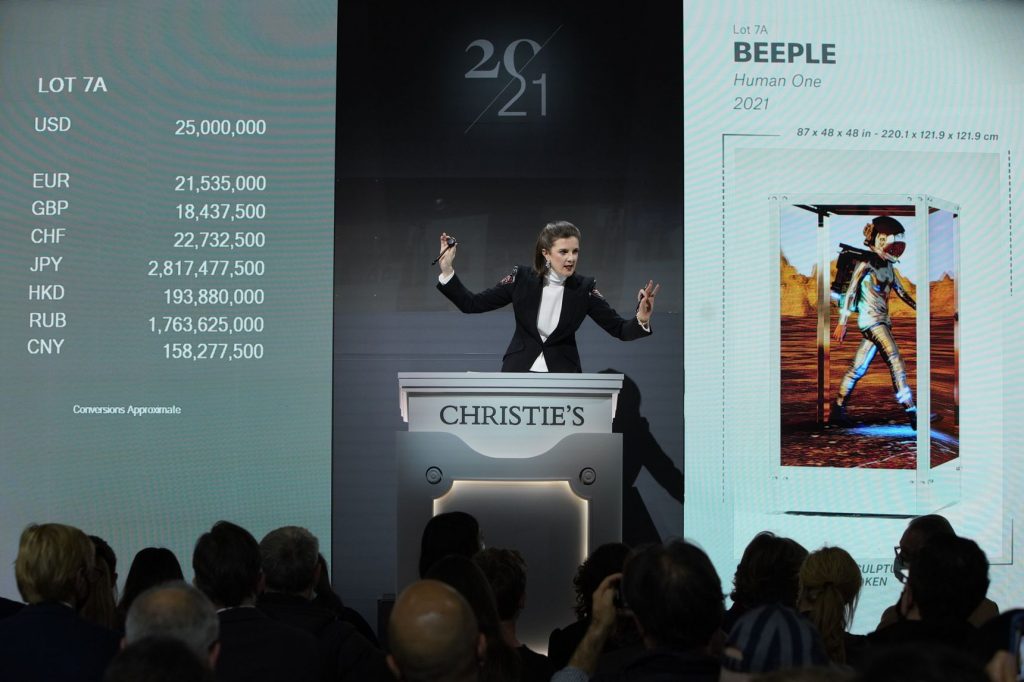Auction houses are some of the longest established organizations for the sale, authentication, and purchase of art. Three major institutions, Sotheby’s, Christie’s, and Phillips were established in 1744, 1766, and 1796, respectively, and have been generally well regarded and trustworthy institutions throughout their history. Recently, their business practices have been most impacted by the increased production of and interest in digital art, as well as digital methods of conducting business. From NFTs to virtual auctions, digital media and methods are increasing profit for and interest in auction houses. Auction houses have quickly adopted various types of technology, though there are many debates and perspectives on what technology will be most useful and popular in the long term, rather than as a passing trend. Meanwhile, responses to auction houses’ increased interaction with technology have varied, particularly since digital business methods have enabled increased activity from hackers, scammers, and money launderers. Overall, digital media and methods are beneficial for auction houses, improving access to the arts and increasing profits, but risks must be carefully considered.
The arts market is one with a constantly shifting value, which auction houses capitalize on in order to drive interest in the pieces that they offer. Depending on the quality, creator, provenance, and history of each piece, expected prices can vary wildly based on the current market. David Bellingham encapsulates the unique nature of the auction business in his chapter, “The Auction Process,” from Art Business Today: 20 Key Topics:
Art auctions differ from other auctions in that each commodity is unique, and therefore an absolute ‘eternal’ value can never be established: the value of each work can only be defined by what an individual was prepared to pay for it at the time of the auction. – David Bellingham
Thus, auction houses are constantly adapting their practices to meet customers’ interests while setting the value of pieces appropriately in the current market. Bellingham goes on to describe how this process is particularly difficult with contemporary art. When pieces appear too quickly at auction, it can be a sign of a bubble, where the pieces will be valued highly at the moment but hold less future value once interest drops. As many customers are looking for pieces that are healthy investments, contemporary art pieces, such as digital works, can pose a risk for auction houses and their continued relationships with customers. However, auction houses are generally seen as reliable sources of high quality and valuable pieces, as their authentication methods are trusted and their prestige lends credibility to a piece’s value.
The value proposition of auction houses creates an interesting challenge for the arts market as a whole when it comes to adopting digital business methods. Because the arts have historically been a luxury market, and continue to be viewed as such, customers want intermediaries such as auction houses and galleries. Marios Samdanis describes this phenomenon in “The Impact of New Technology on Art,” from Art Business Today: 20 Key Topics. According to Samdanis, consumers seek out pieces from these intermediaries, rather than directly from producers, as they perceive a greater “symbolic value” when a piece is sold by a reputable intermediary. Samdanis, writing in 2016, described how digital tools were readily used to market pieces, while social media was being used to increase engagement with existing and potential customers. Technology increased the globalization of the arts market, both in procuring pieces from a wider variety of artists and selling to expanded markets. Partnerships, such as those between Sotheby’s and eBay and between Art Basel and Kickstarter, demonstrated the viability of reaching new audiences and connecting them to artists through technology. Audio, video, apps, and augmented reality were being used to increase viewer engagement and education. However, as of 2016, participants in the arts market were still hesitant to move to fully-digital methods, and digital art was still growing in popularity.
In 2020, however, the entire arts market was shaken by the COVID-19 pandemic. As with nearly every industry, participants in the arts world were forced to conduct their business virtually in the interest of public health and due to governmental restrictions on in-person work and gatherings. While the arts were adopting digital tools as described, no one expected to suddenly rely upon technology so heavily. Auction houses had to reconsider how to best connect to customers virtually, from marketing their collections to hosting auctions. Prior exploration of digital tools proved invaluable to continuing the business and reputation of these institutions.
However, an additional development in the arts world dramatically transformed the business of auction houses, arguably even more so than the shift to virtual business: an unprecedented increase in interest in digital media, particularly NFTs. This explosion was set in motion by the sale of Beeple’s EVERYDAYS: THE FIRST 5000 DAYS, sold by Christie’s for a record-setting $69,346,250 USD on March 11, 2021. This piece, shown below, is a compilation of Beeple’s daily work since 2007, when he first set out to create a new digital image every day. EVERYDAYS brings together these daily images, organized loosely by chronology, theme, and color, demonstrating the artist’s journey in both skill and subject matter.

Beeple, minted on February 16, 2021
An article written the week after the sale by Kelly Crow for the Wall Street Journal describes the intense impact of this sale on all auction houses: suddenly, all major institutions wanted to rapidly increase their sales of NFTs. The Beeple sale had demonstrated that this medium had value in the market, and auction houses were receiving calls from long-time customers and new audiences about buying NFTS. As Crow writes,
Marc Glimcher, president and chief executive of Pace Gallery, likened the atmosphere to a gold rush, saying he’s fielding 25 calls a day from longtime art collectors as well as newcomer cryptocurrency investors angling to get in on the NFT art craze. – Kelly Crow
Cryptocurrency was a major part of this digital craze. Beeple’s EVERYDAYS had been bought by a cryptocurrency millionaire from Singapore known as Metakovan, and as auction houses realized the market for NFTs, they also realized that this market was full of cryptocurrency investors who had an incredible amount of wealth, potential customers who largely were previously unconnected to the arts market. In another quote from Glimcher, he stated that arts institutions were “just now realizing that the crypto community is bigger and richer than the art world.” Arts brokers from all types of organizations, from galleries to auction houses, were investigating how to accept cryptocurrency and increase their portfolios of digital artists. Crow’s article, again written just six days after the sale of EVERYDAYS, demonstrates just how quickly the entire arts world realized the serious interest in digital media and was shifting to meet demands.
However, another article written the very same day expressed concerns with the “trendiness” of this market for NFTs and digital media. While the market demand for NFTs was taken seriously by auction houses and other brokers, there were plenty of doubts about the longevity of this demand. In his article, Connor Goodwin reflected on the growth in popularity of NFTs and particularly how non-traditional players factored into the demand. NFTs are able to be marketed and sold by nearly anyone, and so small organizations and artists themselves are able to directly market and sell their work. For example, Hashmarks, an online artist collective, was able to sell 16,384 NFTs for approximately $16 million on January 27, 2021. Hansen Wang, a co-creator of Hashmarks, reflected on how the success of this sale demonstrated how artist-consumer relationships can break down the hierarchy of the arts world, particularly removing middlemen like auction houses which slow down the sale of pieces and the transfer of funds. This very perspective explains why auction houses so rapidly jumped into selling NFTs and accepting cryptocurrency as payment: sales such as the one by Hashmarks generated enormous profits, and auction houses saw an opportunity to reach new consumers and get a piece of the NFT-money-pie. Goodwin continues to ask two questions: are NFTs smart investments? and are they good enough that the art world should really care? Goodwin expressed hesitancy in answering both of these questions. While the Beeple sale had certainly proved something, many participants in the arts world had doubts about the long-term viability of the NFT market or outright criticisms of the pieces. In March 2021, it was difficult to know how the market would continue to shift.
The rapid development of digital media and methods of sale meant that auction houses had taken up new perspectives only a few months later. Data from November 2021, collected by Art Market Research, stated that Sotheby’s had sold $65 million in NFTs by that point in 2021, while Christie’s had sold over $100 million. All told, NFT sales were approximately 5.5% of contemporary art sales for these institutions. Additionally, Sotheby’s shared that 70% of customers of “Natively Digital: A Curated NFT Sale,” held in June 2021, were new customers, and that many of these buyers were people who had grown wealthy from cryptocurrency.
held June 3-10, 2021
Information about Christie’s involvement in the NFT market was shared by Neda Whitney, Head of Marketing for the Americas at Christie’s, in an interview with Alexandra Bruell at the Wall Street Journal. Whitney shared that in 2021, 34% of total Christie’s customers were new to Christie’s, while 72% of NFT bidders and buyers were new.

In the interview, Whitney shared her perspective on how the marketing for Christie’s needed to adapt to attract new customers. According to her, younger consumers view luxury more expansively than previous generations: luxury is not just traditional art, but also streetwear, wine, watches, and jewelry. Younger consumers can have a great deal of wealth to spend, particularly those employed in technology-based industries, and they are looking to connect with brands over social media and sites such as Discord. Whitney described how her work had grown to include virtual and in-person events to share information about NFTs, and she was behind the promotion of Christie’s auctions through social media campaigns. Overall, she said, she measures success for the institution in terms of new customers and increased brand affinity, as auction houses are seeking greater returns and more customer data.
Whitney’s personal approach, meanwhile, eloquently summarizes the entire reason why auction houses must shift their approach in a digitally-crazed arts world:
My personal goal is to get the narrative of Christie’s into the hearts and minds of all types of clients. – Neda Whitney
One year later, Whitney’s perspective is still accurate. Auction houses are still primarily seeking to explore the world of digital media and business methods in order to meet consumers’ desires, enabling both long-term clients and new customers to feel at home in these institutions. Once again, Beeple served as an example of how auction houses could “settle” in a newly transformed arts world by bringing together traditional sales methods, tangible art, and digital media. In October 2021, Christie’s offered Beeple’s Human One, a seven foot tall sculpture. The frame, made of white mahogany, holds LED screens displaying a walking astronaut. The whole sculpture rotates to display the figure from all angles as they walk through a variety of landscapes.
This sculpture demonstrates how auction houses can continue to auction physical objects with entirely new capabilities. Most notably, the artist can remotely update the sculpture so that the astronaut walks through different backgrounds. Unlike every static sculpture, the owner of this piece will be in constant “contact” with Beeple and experience an ever-changing work of art. Most artists transform over the course of their career: exhibitions, books, and documentaries are dedicated to exploring how famous artists changed in their approach to their work. However, these changes are often explored after the fact. EVERYDAYS did so by capturing in one piece how Beeple’s skill and subject matter transformed over more than a decade. Human One will again display the evolution of an artist, but these changes will be viewed in real time by those viewing the sculpture.

Meanwhile, other artists have been enjoying increased attention due to auction houses’ focus on digital tools and media. In another article by Kelly Crow, she describes how technology has largely diversified what types are art are being sought out. The art world had to reexamine itself over the past couple of years, in response to the pandemic, technological expansion, social justice, and economic shifts. Crow writes:
Huge, shiny sculptures and wall-size photographs oozing luxury or cynicism are out, for now; earnestly expressive portraits and politically potent works by Black artists and women are in—particularly if the artists are young or can be deemed rediscoveries. Tastemakers are also pivoting away from abstraction or coy, conceptual art in favor of pieces that echo issues being raised in the realms of social justice and social media. Some collectors are leaning further into technology by amassing digital artworks, while other sets of buyers are coping by prizing ceramics, with their fragile, lumpen tactility. Demand for dozens of artists has been upended and it’s compelling the art world’s power players to reckon with the fallout. – Kelly Crow
Arts brokers, including galleries and auction houses, have seen dramatic shifts in the marketability of certain pieces and artists as audiences’ tastes shift, and as the audiences themselves shift. Auction houses are critically considering what artists and what pieces they need to be seeking out in order to remain profitable and popular with consumers. In addition to expanding collections, auction houses are also recontextualizing mainstays in order to demonstrate new facets of their work which may resonate more strikingly with the current market.
While the new digitally-focused market has many benefits, relying on technology increases the opportunities for hackers, scammers, and money launderers to benefit. Because NFTs are natively digital, and sales are most frequently conducted online, fake NFTs and fake marketplaces can be used to steal credit card information. Scammers posing as artists can make hundreds of thousands of dollars before they are caught, and while they can then be shut down and/or barred from platforms, there is often no way to recover the stolen funds. Intrinsic features of the digital landscape, like decentralization and the participation of non-tech-savvy consumers, create more opportunities for scammers to profit. Cryptocurrency can also be affected by scammers, and auction houses are having to be vigilant to shut down customers attempting to launder money through cryptocurrency transactions. In response to these risks, companies like Verisart have developed technology to authenticate artworks, particularly NFTs, so that platforms decrease the risk of fraudulent sellers or fake pieces. Auction houses, because of their heightened security protocols, can provide vital verification services for digital pieces, much as they have verified physical artworks for centuries.

The digital landscape is still being formed, and thus auction houses will continue to negotiate and renegotiate their use of digital business methods and their sale of digital media. However, the opportunities for artistic exploration, artist diversification, customer engagement, and profit continue to be tremendously exciting. By balancing their history of trustworthiness with a future full of possibilities, auction houses can remain essential institutions for preserving and disseminating artworks for many years to come.